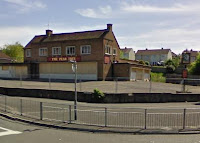A few weeks ago I posted
some sobering statistics showing that total on-trade beer volumes had fallen more than 40% since 1997, and weren’t much more than a third of what they were at what will come to be seen as the all-time peak of the pub and club trade in the late 1970s. Now, obviously people will counter that by saying “well, I regularly go in the Mole & Meerkat and it’s packed every night”, but that doesn’t alter the cold hard facts. Within an overall declining market, it is still possible for some pubs to prosper, and it is clear that the pain has not been spread at all evenly.
Phil has recently posted on his
Oh Good Ale blog descriptions of some of his locals in the Chorlton-cum-Hardy area of Manchester, such as the
Marble Beer House. Chorlton is a rarity in that in recent years the number of bars, and of cask ale outlets, has considerably expanded. Indeed it is that kind of area – prosperous, socially mixed, densely-populated, with a noticeable academic and bohemian element – where pubgoing is likely to survive most strongly. There are plenty of similar areas in London, where I get the impression that pubgoing remains noticeably more healthy than in much of the rest of the country. Contrast that with less well-off Manchester suburbs such as Longsight and Openshaw where most, if not all, of the pubs have now disappeared.
The pub and bar scene in Manchester City Centre gives an impression of health, but that is much less so in the satellite towns. I have written before about
the devastation of the pub stock in Ashton-under-Lyne. Stockport has done better, but even here there has been a steady drip-drip of closures and there are currently probably at least five pubs in the town centre that give the impression of clinging on for their life.
It is also very obvious from looking at the closed pubs on Google StreetView that the big, purpose-built pubs from the 30s, 50s and 60s, whether roadhouse or estate pub, seem to have fared worst of all – possibly
for reasons discussed here, a combination of always being a little soulless and being on spacious sites that appeal to developers.
Outside of the conurbations, in small towns, villages and the countryside, there is surely much more pain to come. Pretty much every non-motorway road journey of any length reveals a fresh pub that is closed and boarded. Now, obviously it is possible to find enterprisingly-run pubs that succeed in locations where many others fail, but even if you are bucking the trend, it doesn’t mean there isn’t a trend.
The question is whether the next ten years will bring just a further thinning-out of pubs, leaving fewer but stronger still standing, or whether we will end up with a situation where large tracts of the country, urban as much as rural, in effect have no pubs at all, as the term is usually understood, and pubgoing will cease to be anything remotely approaching a universal experience. And, of course, in some run-down inner urban areas, that is already pretty much the case.























